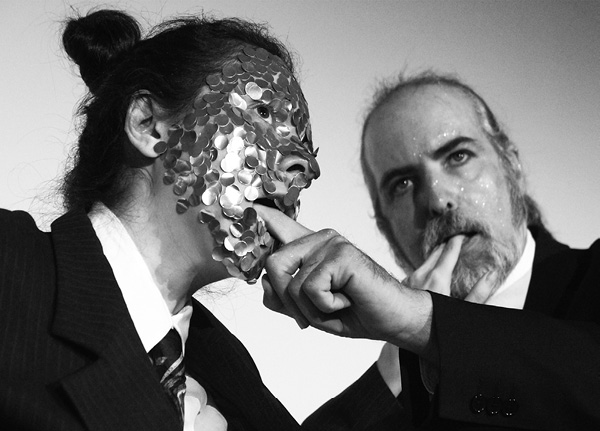
DUPLA REPERFORMANCE (DOUBLE RE-PERFORMANCE)
first performed on April 2, 2016
Galeria Transparente - Showroom - Centro Cultural da Justiça, Rio de Janeiro, Brazil
performed once in 2016
LUCIO AGRA / GRASIELE SOUSA
Sao Paulo, Brazil
112095561g112095561r112095561a112095561s112095561i112095561s112095561o112095561u112095561s112095561a112095561@112095561g112095561m112095561a112095561i112095561l112095561.112095561c112095561o112095561m
contemporaryperformance.org/profile/LucioAgra
cabelodroma.blogspot.com.br
DUPLA REPERFORMANCE (DOUBLE RE-PERFORMANCE)
LUCIO AGRA / GRASIELE SOUSA
We do “re-performances” of historical actions, the common thread between them being a relation between peers.
A group of five historical performances were remade, taking into account actions that required two beings (humans or not). We chose to work with historically significant pairings in the performances, including artists and artists with animals or objects (taken by these artists as emblematic devices of their actions). The couples chosen were: Paulo Bruscky (Brazilian artist—“What is Art”—artist and poster), Gilbert and George “Living Sculptures,” Beuys and dead hare, Marina and Ulay (“Imponderabilia” and “Relation in Time”).
The challenge is to re-perform the same actions, using the resources and bodies available to us. For example, we re-performed the action of Beuys with the dead hare using a woman (Grasiele) in place of the male artist, and a performance scholar (Lucio) as the dead hare. By inverting the official discourses about the role of man and woman, human beings and animals, artists and theoreticians, we deal with consolidated notions of authority as it is considered in a society whose culture is strongly influenced by the most affluent art markets in the world.
We intend to question the meaning of these actions and the reception of the performance in cultures that suffered a process of colonization, like Brazil. We aim to permeate discussions around culture and colonization in the context of present-day Brazil by trying to provoke a shock reaction from the audience, regarding the reception of these art works as usually viewed in the performance art world. We do not aim to deny the value of these historical art works. Instead, we try to engage them in a critically receptive environment, in the so-called Global South, while facing the socio-political tensions and narrative disputes of our times.
The documentation of these performances became available only after the development of the world information networks, something which is also true of perceptions about the production of the Brazilian performance.